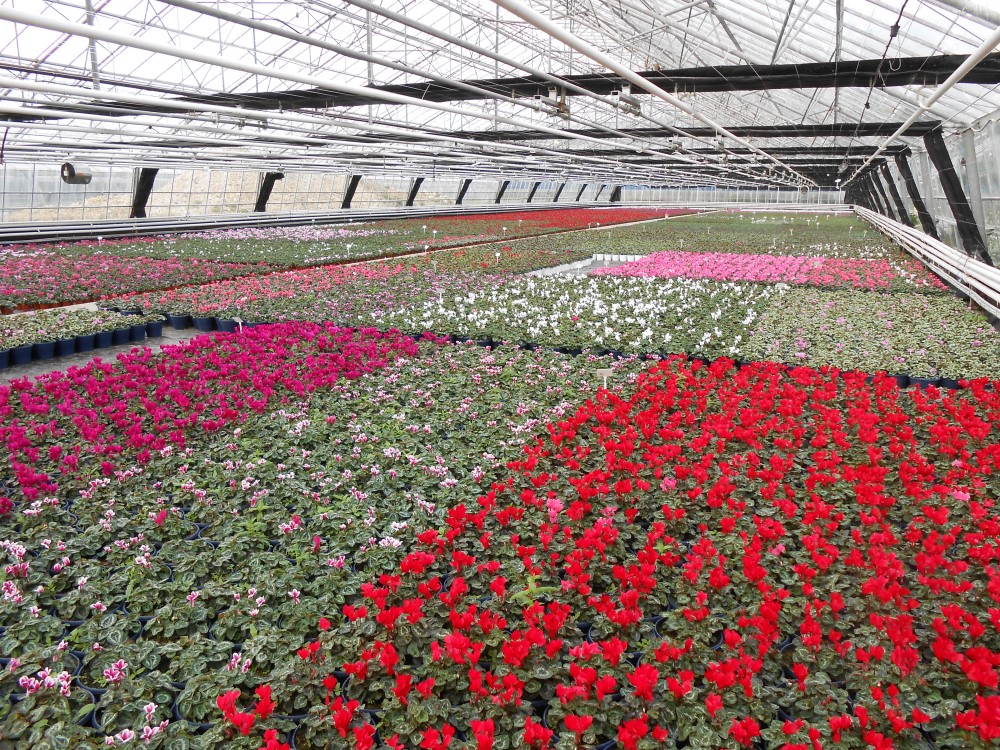Please click here to access the main AHDB website and other sectors.
- Home
- Knowledge library
- Disease control in cyclamen
Disease control in cyclamen
The various diseases associated with cyclamen production can impact plant quality, reduce marketability and, in severe cases, kill plants. Follow the guidance included in these pages to optimise cyclamen disease management.
Learn how to effectively manage diseases of cyclamen
The UK produces in excess of 16m cyclamen in various pot sizes each year. Any disease outbreak will impact the quality and marketability of cyclamen leading to financial losses for growers.
Botrytis (grey mould) and bacterial soft rot are the most common diseases found on cyclamen crops. Other diseases, including phytophthora root rot and fusarium wilt, may also develop sporadically. Although these occur less frequently, they can still have significant impacts on cyclamen crops.
Early and accurate identification of any disease problem is critical. This allows for the most appropriate control measures to be applied quickly to reduce losses.
On the following pages we will review the most common diseases of cyclamen, including best practice strategies for disease management.
Follow the links below to learn more.
Action points
- Clean and disinfect standing areas pre-cropping, including capillary matting
- Cover water storage tanks and open bales, bags or bulk growing media to prevent contamination by pathogens
- Consider using a growing medium containing up to 40% composted pine bark or woodfibre, with nutrition adjusted accordingly
- Plant young plants carefully to reduce wounding and ensure that the top of the corm is well above the growing medium surface to reduce the risk of bacterial soft rot
- Irrigate, preferably via sub-irrigation, regularly but not to excess. Irregular watering can lead to cracks developing in the corm through which bacterial soft rot can enter
- Avoid high nitrogen feeds which lead to soft growth and increased disease susceptibility
- Ensure good air movement though the crop and use glasshouse shading and/or shade screens to help minimise plant stress
- Ensure that senescent leaves and flowers are removed promptly. Remove diseased plants to limit secondary disease spread; carefully bag plants before removal to avoid spreading spores of Botrytis or Fusarium
- Adopt a carefully managed, preventative spray programme utilising both bioprotectants and fungicides
Disease identification and biology: foliar and corm diseases
Learn to identify symptoms of the key foliar and corm diseases of cyclamen, and gain an appreciation of pathogen biology.
Find out more about the foliar and corm diseases of cyclamen
Disease identification and biology: root rots
Learn to identify symptoms of the key root diseases of cyclamen, and gain an appreciation of pathogen biology.
Find out more about the various root diseases of cyclamen
Disease identification and biology: virus diseases
Learn to identify symptoms of the three key viruses of cyclamen.
Identify and understand the viruses associated with cyclamen production
Disease management
Disease management can only be optimised by adopting a range of cultural and chemical control methods.
Adopting a number of cultural and chemical control methods to enhance disease management
Useful links
Read the AHDB Bedding and Pot Plants Crop Walkers’ Guide for more information on some of the diseases associated with cyclamen.
AHDB Bedding and Pot Plants Crop Walkers’ Guide
Authors
Author(s) – Dave Kaye and Erika Wedgwood. ADAS Horticulture.
Original author(s) – Tim O’Neill and John Scrace. ADAS Horticulture.
Web page content correct as of May 2021.
Cyclamen in commercial production

Copyright AHDB.

